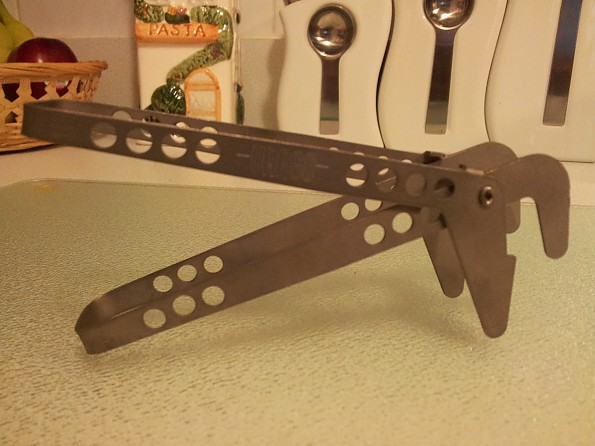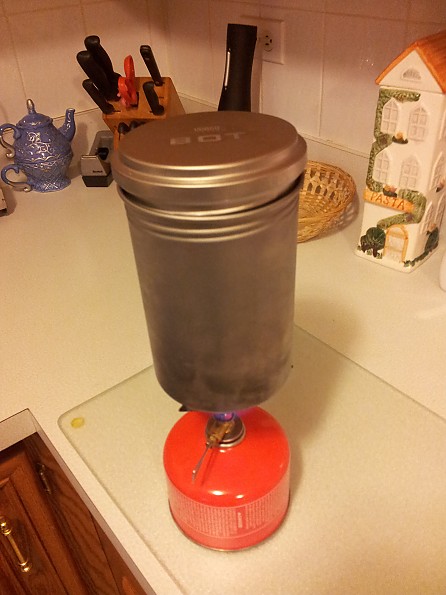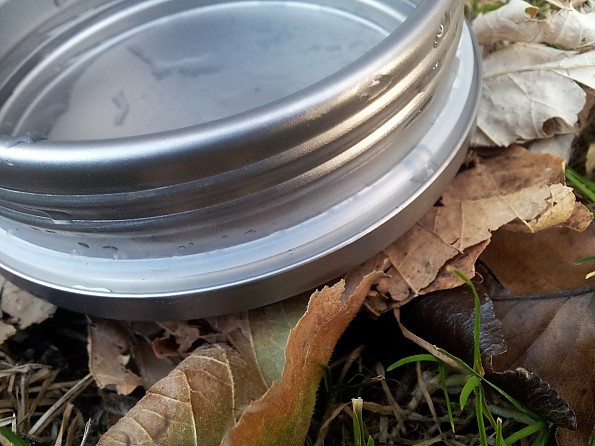Vargo Titanium BOT Bottle Pot

Vargo’s Bot gracefully combines a functional 1-liter titanium pot with a screw-on titanium lid to create a versatile object capable of both cooking and storage. It is the epitome of simplicity, with just two precisely machined titanium pieces and a fat silicone ring to perfectly seal the bead. The titanium is thick, and a sealed Bot is functionally indestructible.
Pros
- The Bot is perfectly sized for use with both modern canister stoves and wood, alcohol, and Esbit stoves
- Over-tall design creates ample room for cooking extra-big portions of pasta, couscous, and the like…
- Wide mouth design is super easy to clean, works perfectly with wand-style UV water purification
- Serves perfectly as a food canister in non-bear-populated areas where critter protection is still desired
- Incredibly solid construction; should last years, if not decades, of regular use
- An unbelievable 4.7 ounces for a nearly indestructible cooking pot that doubles as a water bottle—or is it the other way around?
- Clean-up is a breeze, as is storage
Cons
- In freezing conditions, ice can gum up the threads, potentially freezing the Bot shut
- I suppose the silicone o-ring will wear out in, maybe, 10 years, so that’ll be something…
UPDATE 4/2017: As I suspected the O-ring finally went, after putting the BOT directly on a campfire with the lid barely affixed (to keep ashes out of the water). Dumb move on my part...Flames licking up the side charred the O-ring, though not completely through. Called up Vargo, and they mailed me out a replacement same day, free of charge.
Best For: UL backpackers carrying small-volume backpacks. All those masochists among us who don’t like packing more than two water bottles, knowing one of them will, at some point, be used for urine storage. Also…Anyone anywhere wanting to store or heat water or food…so everyone alive.
Design: Just shy of “bomber” (That is what the kids are saying these days, right?): Thick, sturdy titanium throughout, with an opaque-white silicone o-ring approximately 3/16" in diameter seating the inner pot at the top of the threads. Fat and flexible, this seals more than adequately, allowing both a wide-mouth opening and thick titanium wall.
The Bot will dent if you hit it with a hammer, but under normal backpacking use it has proved to be functionally indestructible. I imagine a bear would do some damage to it, but I don’t know of any such testing Vargo’s conducted, and I couldn’t find a bear…
The BOT, assembled and ready to rock...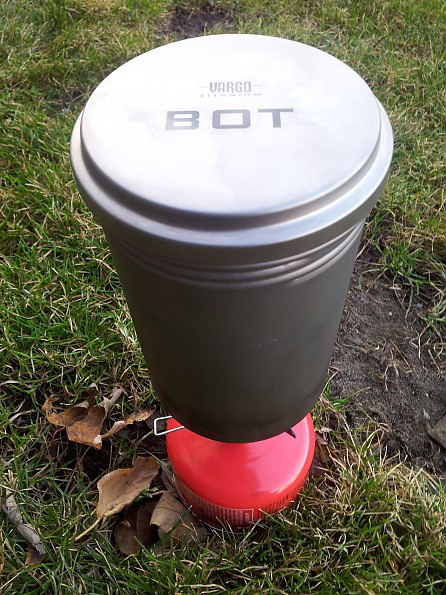
As a pot it is well-designed; tall enough to hold a good mess of noodles, and wide enough to be stable on most backpacking stoves. It indeed rests well on my both my canister stove and wood stove. It is sufficiently wide enough to prevent flames spilling over and up the sides, unless ones stove has a very wide flame pattern. The Bot is definitely large enough to cook to for two.
As far as handling the Bot when filled with scalding-hot water or food, Vargo does make an uber-light pot gripper—which I’ve used and works very well—though I’ve taken to using any old generic silicone wrist band as a “gripper” of sorts, stretched across the rim of pot. (And if the band being used is stamped with a phrase, put the stamped side in to act as extra dead air space...)
Now, using the silicone-band method gives one a cool place to grab the pot to take it off the stove, but that’s about it, so plan accordingly. (In theory one could screw the lid onto the pot and use that connection to remove the pot, buuuuuuuuttttt…that’s more an “advanced” technique and certainly not one I, or Trailspace, would recommend to the inexperienced.)
Another interesting touch is that the lid can be inverted on the pot when boiling water, creating a sort-of seal just on account of the weight of the lid resting across the rim. Well, when one's water starts boiling, the lid ends up doing a little babbling dance to audibly alarm its status.
BOT with silicone band on rim...
As a storage vessel the Bot is equally well-purposed, adept at keeping both water and food contained. I’ve found it to be absolutely watertight, and pretty well odor-proof. In service as a water vessel its super-wide mouth opening allows easy use of any UV sterilization wand, not to mention making it lightning-fast to fill up.
Moreover, I was quite surprised to see how useful the Bot is at carrying food. Though its overall size really limits capacity in this regard, I find the Bot is just large enough to hold a weekend’s worth of food (well, 5 meals…) for one person. On multiple occasions I would just set it out on the open ground beside my bivy, awaking in the morning to see critter tracks in the dirt all around camp with no sign of any of them messing with the Bot.
BOT lid, with standard Bic lighter for scale...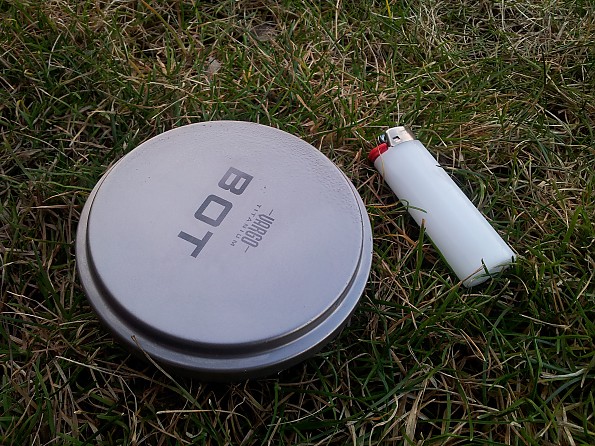
Styling of the Bot is subtle. There is a single, unobtrusive printed-on logo on the lid. A matte finish to the titanium provides good grip, and it will, of course, blacken and/or turn all colors of the rainbow once exposed to heat. Aesthetically, I find the Bot beautiful in its simplicity. Just something about the symmetry and proportions of the Bot really resonates with my inner industrial designer.
Performance: I find that for products like this, comparisons are often helpful ; my current pots are, in order of largest to smallest: an aluminum .9L Primus EtaPower pot (with welded Flux Ring), a titanium .6L Evernew pot, and a titanium .475L Mountain Laurel Designs pot that also doubles as a cup.
I compared the Bot to these three pots in a few areas I feel are critical to backcountry cooking: boil times, packability, and overall versatility. I use multiple stoves with multiple packs and camp in every season, so I like it when the things I own are all-round performers.
BOT bottom half next to 475ml MLD pot for scale...
For the boil tests I took two cups of tap water and put it in each respective pot and threw that over my canister stove, on an 8oz Iso-Butane canister about ¾ full. I thought about buying 4 individual canisters and cracking a fresh one for each pot, but I came to the conclusion that I’d have no way of knowing if doing so standardized my results in any way.
Anyways, I found that in standard boil tests the Bot would get two cups of tap going faster than all but the EtaPower pot, though there is no reason one couldn’t just use any of the separate flux rings on the market today with the Bot. This is saying quite a bit, however, as the EtaPower pots produce some of the fastest boil times currently possible with backpacking equipment.
After a bit of seasoning, the Bot averaged a 3-minute, 40-second boil time for two cups of 55°F tap water. (It should be noted here that for my boil tests I generally run my stove at 90%, or a quarter-turn backed-off from full blast.) Given the similar diameter and volume capacity between the EtaPower pot and the Bot, I’d think that the addition of a flux ring would put it right up there with the most efficient pots available.
BOT on my canister stove, underside detail...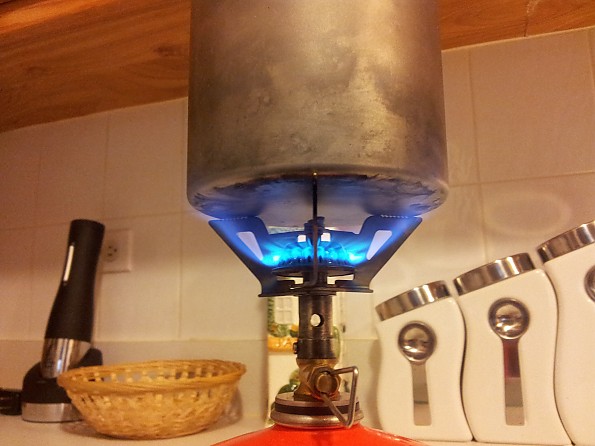
As far as packability, the Bot is has the largest packed size of all my pots, though it also has the highest capacity. That being said, the Bot is still really no bigger inside the pack than any other 1L water bottle. And finally, a cooking system with no sharp edges or protruding handles to catch on pack contents!
I’m hard-pressed to find a critique here, though one slight annoyance is that since the Bot is so pure in its design there really is no need for a carrying sack—and indeed, on is not included—so any grime built up on the sides of the Bot is free to transfer to anything else one puts next to it. Luckily, I’ve got a bajillion stuff sacks of varying sizes, so I just pack it into one of those. Again, plan accordingly.
Another note is that while I used an 8oz fuel canister for my testing, only the smaller 4oz size will fit inside the Bot (though it will fit two of them, with a stove...)
BOT with 4oz fuel canister and stove inside...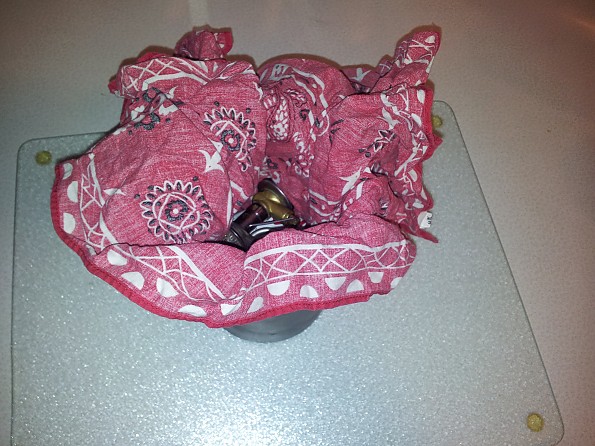
BOT on the side of my Zpacks/KUIU pack...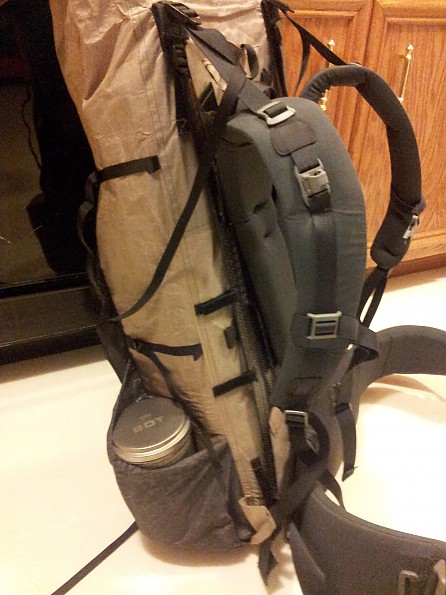
Our last consideration is perhaps best expressed thusly: All things considered, which pot do I take on a given trip? Well, if I’ll be cooking for two, or if I know I’ll want tea/coffee as well, I’ll usually want to bring a pot that can, at a minimum, hold right around four cups of water. If I want a pot that can hold a liter, these days I’m bringing the Bot.
Even though the EtaPower is a faster pot — and it is a wonderful pot, lid-that-doubles-as-a-frying-pan and everything — the fact that the Bot saves the weight and space of a 1L bottle is a pretty significant one. Really, unless I plan to fry a few eggs or do a quick quiche/cake, or am in extreme need of space (i.e. bringing a 475ml MLD pot, UL wood stove, Evernew collapsible water bottles…) the Bot wins.
There is, however, one final specific point here to make, which is that if freezing conditions are expected it is especially critical to keep the Bot from freezing. Was water to be trapped in the threads and frozen, the metal-on-metal connection could freeze shut, not to mention that freezing water in an enclosure without air space adequate enough to allow for expansion = fractured enclosure.
This is enough to make me at least consider other options during the winter months…Though I am thinking of making a cozy for the Bot out of a bubble mailer and part of an old space blanket. I'll write an update if that ever comes to fruition...
Clean Up & Maintenance: The pot part of the Bot is very easy to clean on account of the radiused corners and wide-mouth design. Though the lid is really unusable for cooking and really shouldn’t get that mucked-up, it is also cleaned easily. Just a bit of water and soap and some kind of grit on both is all that’s needed. The titanium is pretty resistant to change, so one can really bear down on it with as much abrasion or chemicals as needed. This is not a beer-can pot that dents when you look at it wrong.
As far as the thread connection goes, it is easily accessed and can be cleaned with a cloth or brush and soap. The o-ring comes off with some effort, when cleaning and oiling is required; being a very supple silicone rubber, it should last years and years of abuse without need of attention, and even then just a couple drops of mineral oil and its happy again.
BOT, wide mouth opening and threading detail...
Conclusion: There really is much to like about the Bot. It’s inventive in a way that makes me wonder why no one thought of it before. A very practical, utilitarian object that also happens to be both genius in its simplicity and gorgeous to look at, the Bot is a combination that is as rare as it is seemingly outdated. And yet Vargo carries the torch; then again, when you work in titanium…
BOT with inverted lid, in babble mode...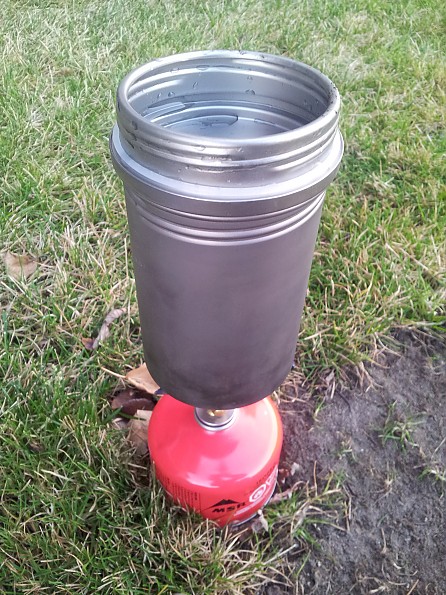
Testing Conditions:
Location: Porcupine Mountains State Park, Hiawatha National Forest, and Pictured Rocks National Lakeshore; Michigan’s Upper Peninsula.
Average late fall conditions for our area of UP, with temperatures ranging in the 30s and lower 40s during the day, dipping into the 20s at night.
About the Author:
Vince Contreras has been working as a professional Forester and Ranger for various federal land management agencies since graduating with a Bachelors Degree in Forestry from Southern Illinois University in 2010. He enjoys rock climbing, backpacking, and German Idealism. Other hobbies include leatherworking, bushcraft, and really, just creating original things.
Vince always welcomes questions and suggestions from his readers. Visit his Trailspace page at: www.trailspace.com./people/pillowthread or email him at pillowthread@yahoo.com
Source: received for testing via the Trailspace Review Corps
(sample provided by Vargo for testing and review)
I do not recommend this product. It sounds like a great idea: water bottle, cook pot, and less weight. In reality the lid gets stuck with any pressure change: elevation change or temperature change of contents. You cannot get the lid off without something to break the seal — a screwdriver works great.
I do not want to have to get other things out of my pack when I want a drink. That is way too complicated. It is extremely tippy when using as a pot due to its height. I am going back to my ti pot and lexan bottle.
Pros
- Less weight
Cons
- Too tall to cook in
- Can't reliably get the lid off
Nothing more to say than the summary.
It sounded great. Bought it. At the trailhead could not get the lid off. Two big men could not get the lid off. A screwdriver easily broke the pressure seal that had formed from elevation change.
This happened several times throughout the trip. Put hot liquid in it to use on day hike. Could not get lid off when liquid had cooled some.
Found it very tippy as a cook pot. I'd make the lid plastic to decrease the internal friction in the threads and have a simple lid for cooking. You must have insulation on your hands if it is full of something hot. The metal transmits a lot of heat, not like Lexan.
Source: bought it new
Price Paid: $100
Great pot and bottle combined! Or bottle and pot...either way.
Pros
- Both a bottle and a pot!
- Incredibly lightweight
- Safe, with no leeching of chemicals
Cons
- Noisy when unscrewing cap
Weight is predictably light, as is everything made from titanium. More important is the safety of titanium, which does not impart any impurities to water or food, making it biocompatible and the safest metal that exists.
This seems to be exceptionally well made, and should last a very long time. It does make a bit of metal-against-metal noise when removing the cap, so you are never going to be able to sneak a drink, but most of us do not care about that anyway.
I have used the Bot for nearly two years now and it is as good as the day it was delivered.
Source: bought it new
Price Paid: $89
Your Review
Where to Buy
You May Like
Accessories: Vargo BOT Cozy,
Specs
| Price |
MSRP: $99.95 Current Retail: $99.95 Historic Range: $79.97-$103.99 Reviewers Paid: $89.00-$100.00 |
| Weight |
4.7 oz / 133 g |
| Size |
4.1 x 6.3 / 105 x 160 mm |
| Capacity |
34 oz / 1L |


















 Reviewed by
Reviewed by
